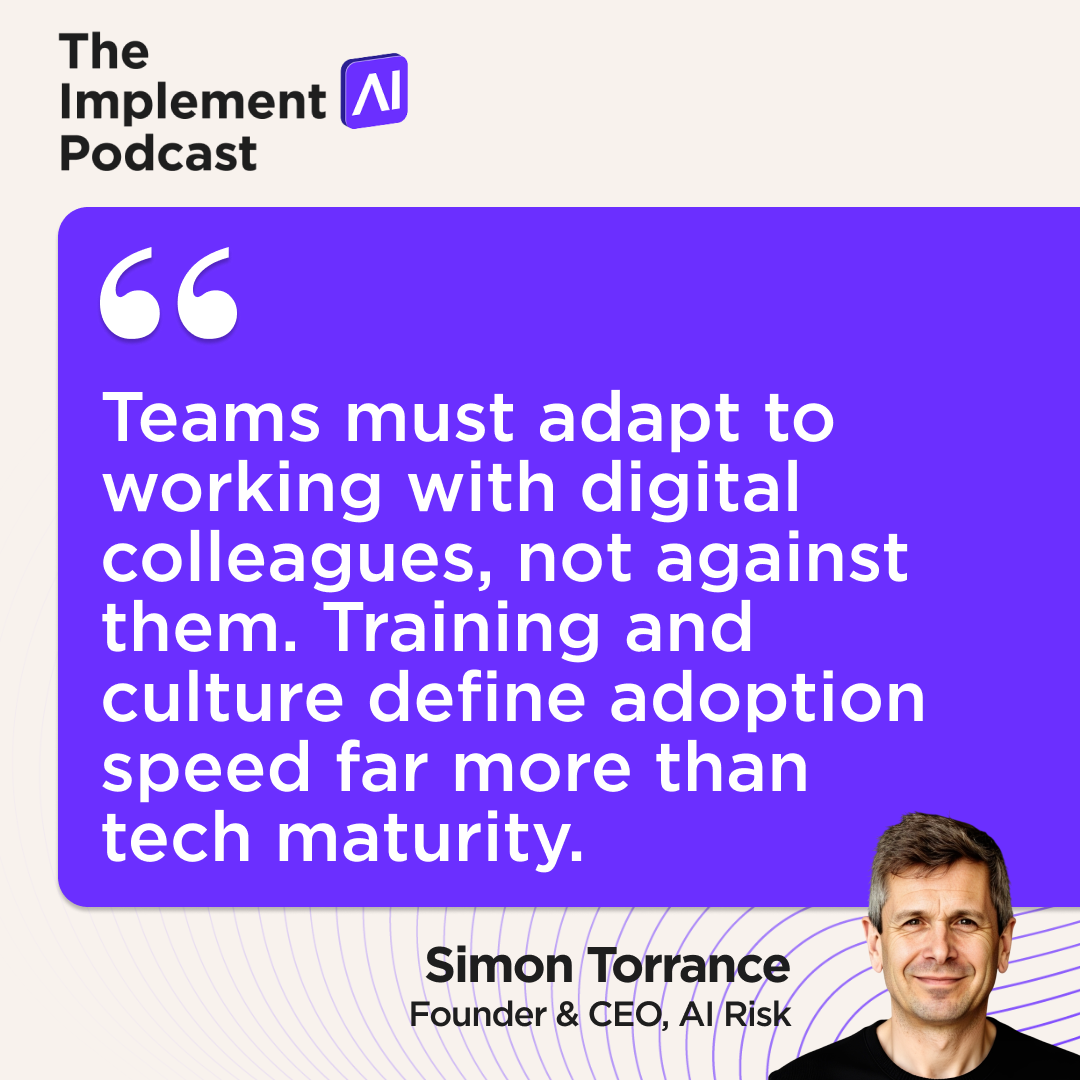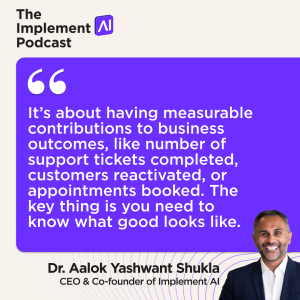The Implement AI Podcast #71 – The 10 Hidden Layers of Agentic AI: Building Systems That Deliver Real Value
November 18, 2025
Every organisation is talking about AI.
Few understand what it takes to make it actually work.
In this new episode of The Implement AI Podcast, Piers Linney and Dr Aalok Y. Shukla sit down with Simon Torrance, founder of AI Risk and a partner with over 30 years in strategy, innovation, and venture creation, to unpack the 10 hidden layers that transform an AI experiment into a productive, reliable, and audit-ready system.
For most businesses, the space between buying AI and having AI that delivers value is vast. This conversation maps that gap, from capacity architecture to governance frameworks, and explores how Agentic AI is redefining what scale, reliability, and accountability really look like.
From Buying AI to Building Capacity
The easiest part of AI is getting access to it. The hardest part is getting value from it.
Simon explains that most organisations start with tools and prompts but overlook the foundation – the “architecture of capacity.”
Before you automate anything, you need to understand what capacity actually means in your business.
Each role, process, and deliverable must be broken into measurable, repeatable units of productive work. Only then can digital workers take meaningful responsibility.
As Dr Aalok Shukla puts it:
“It’s about having measurable contributions to business outcomes, like number of support tickets completed, customers reactivated, or appointments booked. The key thing is you need to know what good looks like.”
When capacity is mapped clearly, businesses stop talking about “AI productivity” in vague terms and start measuring throughput – real tasks completed, outcomes achieved, and hours reclaimed.
The 10 Hidden Layers of Agentic AI
Behind every working AI system sits a framework of ten critical layers.
These layers are not theoretical, they determine whether an organisation can scale automation safely and effectively.
- Capacity Architecture – Define what productive work means before assigning it to AI.
- Workflow Engineering – Design the handoffs between humans and agents.
- Knowledge Infrastructure – Give agents structured, validated data they can trust.
- Integration Layer – Connect your systems so AI can act across, not within, silos.
- Quality Assurance – Build validation loops; agents must check or trigger reviews.
- Performance Monitoring – Measure outputs, not prompts. Benchmark real outcomes.
- Reliability Engineering – Plan for failure. Resilience and redundancy are essential.
- Cost Optimisation – Move from per-user costs to per-output economics.
- Governance Frameworks – Decide who approves, escalates, and audits every action.
- Change Management – Help people learn to work with digital colleagues, not around them.
Each layer builds on the one before it. Together, they create the operating system for Agentic AI, systems that can think, act, and learn within defined limits.
As Simon Torrance explains:
“The biggest risk is not adopting Agentic AI quickly and effectively enough. I help companies, big and small, work out how to exploit Agentic AI to change their business model for competitive advantage.”
Why Governance Is the New Competitive Advantage
In an Agentic AI environment, governance is not a back-office process, it’s the backbone of trust. Every decision, every escalation path, and every piece of output must be traceable.
Piers Linney summarises it perfectly:
“The great thing about Agentic AI is it’s all recorded, an immutable record and a perfect audit trail.”
That traceability changes how companies think about accountability. Audit-ready AI means fewer compliance risks, faster approvals, and a stronger foundation for innovation.
When organisations know exactly what their AI systems are doing and why, they move faster with more confidence.
From Experiments to Outcomes
The difference between pilot projects and productive systems is measurement.
Teams that define “what good looks like” can benchmark their AI output like any other department.
In one case discussed during the episode, human review dropped from 70% to 30%, while operational costs fell by €2 million and customer satisfaction (NPS) rose by 25%.
Those are not projections, they’re the results of applying the 10-layer model to real workflows.
Aalok notes that this shift changes the economics of growth:
Once reliability, performance, and cost per productive unit are measurable, scaling becomes predictable. You’re no longer hiring for hours; you’re investing in throughput.
The Human Side of Change
Technology transformation always comes down to people.
The final layer, change management, determines adoption speed and cultural alignment.
AI systems thrive when teams understand how to collaborate with them.
Training, communication, and role clarity help employees see digital workers as allies that remove friction, not as threats to their contribution.
Simon reinforces this point:
“Teams must adapt to working with digital colleagues, not against them. Training and culture define adoption speed far more than tech maturity.”
When humans and digital colleagues operate in sync, the organisation becomes more adaptive, more consistent, and more resilient.
How to Start
Every organisation can begin applying the 10-layer model today.
- Step 1: Map your capacity – break work into measurable tasks and define outcomes.
- Step 2: Identify where handoffs between humans and agents create friction.
- Step 3: Build a simple governance loop – who reviews, approves, or escalates actions.
- Step 4: Track real business metrics – customers served, tickets closed, hours saved.
- Step 5: Train teams early – help them understand what AI can and should do.
Small, structured experiments build the muscle for larger deployments later.
Key Takeaways
- AI value is built, not bought – start with structure, not software.
- Capacity and workflow design define productivity before automation begins.
- Governance, QA, and reliability convert ambition into sustainable systems.
- Measurement is maturity: track outputs, outcomes, and auditability.
- Culture determines success – train teams to lead with trust and clarity.
Final Thoughts
The next generation of business growth will not be powered by more tools, but by better systems.
Agentic AI is not a trend, it’s a structural shift that demands intention, rigour, and leadership.
As Piers Linney puts it:
“AI will find novel ways to operate outside the box if you don’t define the four corners clearly.”
The organisations that build those four corners – capacity, governance, reliability, and change, will lead the next decade of digital transformation.
🎧 Listen to the full episode now:
Apple: https://bit.ly/4p8sN4v
YouTube: https://bit.ly/4r2JdNC
Spotify: https://bit.ly/4hY83K9





